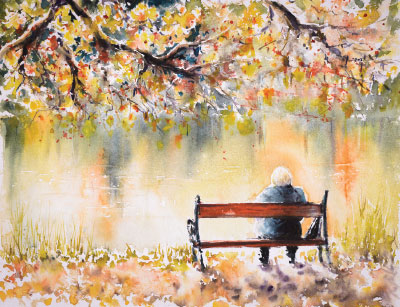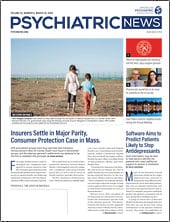For many years, I have entertained the fantasy of surveying psychiatrists to see how many of them entered our profession out of a need—conscious or unconscious—to understand the mental illness they saw in their family of origin. There is a somewhat malicious popular mythology that we become psychiatrists because we are “crazy” ourselves; the truth, I suspect, is that many of us are seeking to repair what happened to someone we loved.
It has only been fairly recently, later in my career, that I have come to realize this truth about my own professional journey. My mother’s bipolar disorder wasn’t diagnosed until I had left home and entered college, but her illness was part of the wallpaper of my childhood—as such I never thought of my childhood, my mother’s condition, and the sometimes strange way it caused her to behave as anything but normal.
Isn’t that the way it is with our patients who have experienced all types of early traumas, even actual physical or sexual abuse or neglect? I never experienced such things; my mother was a lovely woman, and both of my parents did the best they could, as parents do. But coming to realize the extent to which my mother’s illness permeated my childhood and eventually determined my own professional course in life has caused me to appreciate anew the lasting effects of trauma, the stigma associated with acknowledging a mental illness, and the ways in which mental illness ripples out across generations.
I have learned that on my mother’s side there were several family members with serious mental illness, most likely bipolar disorder, and an uncle of mine who died by suicide. My mother grew up in New York City; while in college, her mother died suddenly from complications associated with a surgery that my mother didn’t know she was having. This event precipitated what I suspect was her first episode of depression.
When my sister was born, my mother experienced a serious postpartum depression for which she received no treatment. My father was a physician in training at the time, and we had moved to Framingham, Mass., where he was doing a year of pathology as part of his internal medicine residency. He was on call every other night and my mother, only 25 at the time, was isolated from both friends and family with two children under the age of 3. I was sent to nursery school at only 2 and a half—something that was highly unusual in the 1950s. Subsequently, my mother would proudly tell the story of how I left in a taxi “without a backward glance” to go to “Little Folk Farm.” It took me years before I realized that most children would likely not have responded that way to a separation.
Throughout much of our childhood, my mother did not get out of bed in the morning; our father took care of the usual household activities, made us breakfast, and sent us off to school. We certainly had furniture in the house, but the house was never decorated with a sense of style and warmth as the homes of some of my friends were.
I remember always trying to cheer her up. I would come home from school and regale her with everything that happened—it may be where I acquired a penchant for storytelling (and talking a lot!). She loved it, and my friends loved her. She was engaged and involved in my life, but basically quiet.
When I left for college, my father moved the family to a smaller house. Several years earlier, he had moved his “home office” to an office building that he bought with a dermatologist colleague. It was after my departure and the move that my mother became seriously depressed, and my father took her to a psychiatrist. She was prescribed one of the older tricyclic antidepressants. The medications may or may not have activated a manic episode, but my mother then underwent what now seems like the beginning of a profound personality change—running for the local school board (she was elected), becoming increasingly energetic and “happy.”
Several months later, in the summer between my freshman and sophomore years, the family took a trip across the country. My mother’s behavior became extremely erratic: talking garrulously to strangers, writing copiously in a diary (even her handwriting began to change), spending money (she had always been very cautious), talking openly about sex, and becoming extremely protective of my younger sister, whom she felt she had “neglected” in our sibship of three. Toward the end of our trip, I begged to go off on my own and left to return to New York on the train by myself. When my family returned, my mother was clearly in the middle of a manic episode.
She was initially hospitalized on a general psychiatric unit at a local hospital and subsequently admitted involuntarily to a psychiatric facility. It was at that point that my father announced he was planning to get a divorce—that this was best for my mother since she had “nothing to come home to.” In the years between 1966 and 1972, she was in and out of hospitals, alternately suicidal and manic, and received multiple rounds of electroconvulsive therapy. It was only following an extended inpatient hospitalization and subsequent treatment with lithium that my mother’s moods stabilized. Sadly, by that time, she was living in another city, isolated from friends and family and working in a job that was way beneath her level of education.
My mother died in 1985 of emphysema at the age of 60 (she had been a lifelong heavy smoker and was unable to stop); she never fully recovered from her mental illness or regained the network of friends and family that had been so important at earlier points in her life. With the passing of time, I have become increasingly emotionally aware of the tragedy of mental illness in my mother’s life and of the shadow it cast on the lives of everyone in the family. And I am now more acutely appreciative of how deep and lasting must be the scars that are borne by our patients who experience the kinds of more extreme trauma that I and my siblings never did.
Several months ago, I was speaking with my friend and colleague Ken Rosenberg about his masterful film, “Bedlam: An Intimate Journey Into America’s Mental Health Crisis” (
Psychiatric News). It’s an immensely powerful experience; it will air on PBS in April and will be shown in its entirety at the APA Annual Meeting in Philadelphia. I urge you to see it. The creative impetus for Ken’s work was his late sister’s long struggle with serious mental illness.
I mentioned my mother’s illness to him. “You know,” I said, “it is nothing I’ve ever kept hidden. But I have also never really acknowledged it openly, never really allowed myself to see how much it affected me and the trajectory of both my life and my career.”
Ken urged me to write about it, so I have. The power of stigma is overwhelming; the effects of serious mental illness on a family are lasting and reverberate through the years.
Take it from me. ■
Editor’s note: With this article, Psychiatric News is launching a new column in which APA members are invited to share personal stories that taught them important lessons, gave them meaningful insights, changed their lives—in short, touched them in some way from which others might learn. Stories can be related to personal or professional experiences. If you are interested in sharing such a story, please contact Cathy Brown. 

